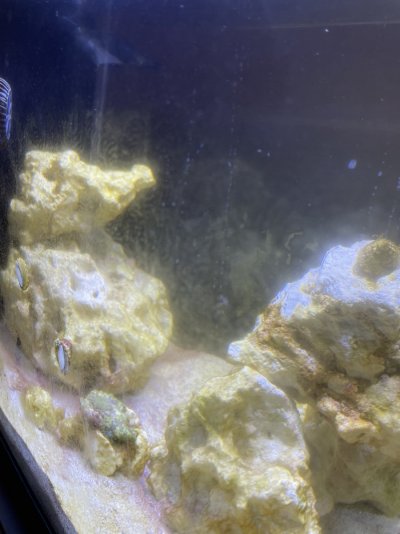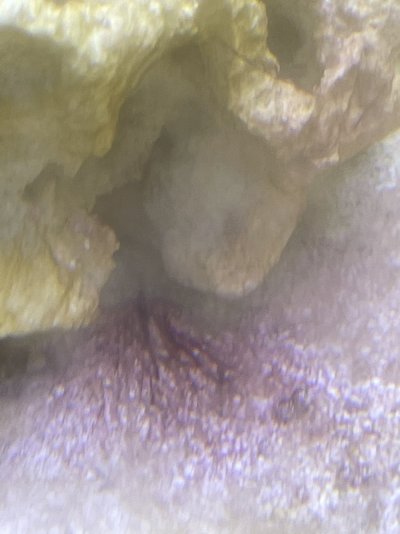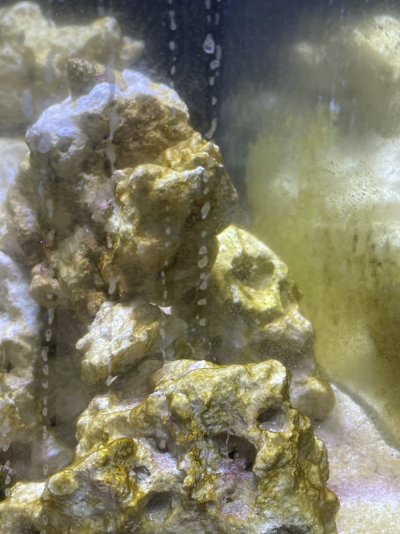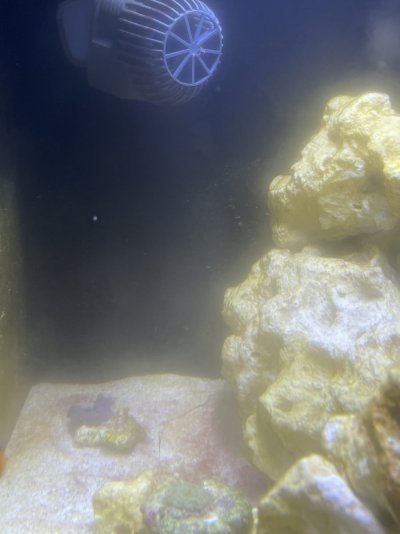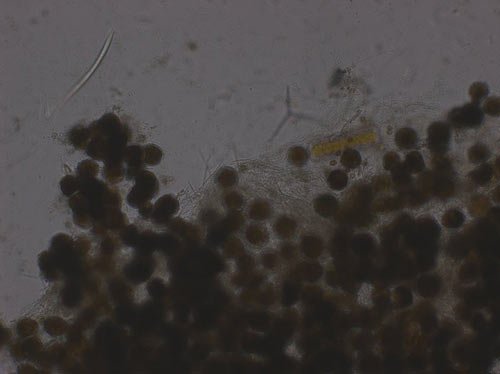You're so lucky to have a microscope. That would help solve 99% of my algae issues. Well when I had cyano and other stuff. GHA is pretty easy to spot. Its green. And hair-like.
Navigation
Install the app
How to install the app on iOS
Follow along with the video below to see how to install our site as a web app on your home screen.
Note: This feature may not be available in some browsers.
More options
You are using an out of date browser. It may not display this or other websites correctly.
You should upgrade or use an alternative browser.
You should upgrade or use an alternative browser.
Is this red stuff Cyanobacteria or Dino’s?
- Thread starter Sushiboy225
- Start date
- Tagged users None
- Joined
- Mar 20, 2017
- Messages
- 1,342
- Reaction score
- 1,205
while that's true in most cases it isn't that cut and dry which is part of the reason a microscope is a valuable tool. OP supplied photos which are invaluable and should be considered over a generalization of the usual appearance as who knows, OP could have both!Pics look like cyano red mats, Dino are usually brown and snotty
- Joined
- Sep 21, 2018
- Messages
- 6,720
- Reaction score
- 7,197
I agree on the ID based on color and film/slime appearance. It is the darn organism as @taricha points out that are not only what we did not expect to see but also do not give us clues as to what they are. The thick sheath that surrounds the organism might be a clue. Lots of things make snotty or slimey films and won’t help much.Pics look like cyano red mats, Dino are usually brown and snotty
- Joined
- Aug 24, 2016
- Messages
- 1,506
- Reaction score
- 2,299
Obviously these are cyanobacteria of spherical shape (coccal), maybe Synechococcus or similar. I thought I knew a red coccal cyanobacterium but I don't recall the name.
Sometimes I find single cells of red coccal cyanobacteria when I examine sediment samples under the microscope but never forming mats yet.
Sometimes I find single cells of red coccal cyanobacteria when I examine sediment samples under the microscope but never forming mats yet.
- Joined
- Sep 21, 2018
- Messages
- 6,720
- Reaction score
- 7,197
@Hans-Werner thoughts on this one?Obviously these are cyanobacteria of spherical shape (coccal), maybe Synechococcus or similar. I thought I knew a red coccal cyanobacterium but I don't recall the name.
Sometimes I find single cells of red coccal cyanobacteria when I examine sediment samples under the microscope but never forming mats yet.
vetteguy53081
Well known Member and monster tank lover
View Badges
Partner Member 2024
Excellence Award
Reef Tank 365
RGB
Article Contributor
Tampa Bay Reef Keepers
West Palm Beach Reefer
Hospitality Award
Ocala Reef Club Member
305 Reef Club
Wisco Reefers
Midwest Reefer
Fish Medic
MAC of SW Florida
Rock Pool Reef Keepers
R2R Secret Santa 2023
My Tank Thread
My Aquarium Showcase
Cyano - no doubt
Cyano blooms typically start when water nutrient concentrations go haywire. Just like when you eat too much sugar and your waistline starts to bloom, the same happens in your tank when concentrations of phosphate, nitrate and other organic compounds are too high.
Some of the most common causes include:
- Protein skimmer which fills water with tiny air bubbles. As bubbles form from the reaction chamber, dissolved organic compound molecules stick to them. Foam forms at the surface of the water and is then transferred to a collection cup, where it rests as skimmate. When the protein skimmer does not output the best efficiency or you do not have the suitable protein skimmer to cover the tank, the air bubbles created by the skimmer might be insufficient. And this insufficiency of air bubbles can trigger the cyano to thrive.
- Overstocking / overfeeding, your aquarium with nutrients is often the culprit of a cyano bloom
- Adding live rock that isn’t completely cured which acts like a breeding ground for red slime algae
- If you don’t change your water with enough frequency, you’ll soon have a brightly colored red slime algae bloom. Regular water changes dilute nutrients that feed cyanobacteria and keeps your tank beautifully clear
- Using a water source with nitrates or phosphates is like rolling out the welcome mat for cyano. Tap water is an example
- Inadequate water flow, or movement, is a leading cause of cyano blooms. Slow moving water combined with excess dissolved nutrients is a recipe for pervasive red slime algae development
I recommend to reduce white light intensity or even turn them off for 5-7 days. Add liquid bacteria daily for a week during the day at 1.5ml per 10 gallons. Add Hydrogen peroxide at night at 1ml per 10 gallons. Add a pouch of chemipure Elite which will balance phos and nitrate and keep them in check.
After the week, add a few snails such as cerith, margarita, astrea and nassarius plus 6-8 blue leg hermits to take control.
Cyano blooms typically start when water nutrient concentrations go haywire. Just like when you eat too much sugar and your waistline starts to bloom, the same happens in your tank when concentrations of phosphate, nitrate and other organic compounds are too high.
Some of the most common causes include:
- Protein skimmer which fills water with tiny air bubbles. As bubbles form from the reaction chamber, dissolved organic compound molecules stick to them. Foam forms at the surface of the water and is then transferred to a collection cup, where it rests as skimmate. When the protein skimmer does not output the best efficiency or you do not have the suitable protein skimmer to cover the tank, the air bubbles created by the skimmer might be insufficient. And this insufficiency of air bubbles can trigger the cyano to thrive.
- Overstocking / overfeeding, your aquarium with nutrients is often the culprit of a cyano bloom
- Adding live rock that isn’t completely cured which acts like a breeding ground for red slime algae
- If you don’t change your water with enough frequency, you’ll soon have a brightly colored red slime algae bloom. Regular water changes dilute nutrients that feed cyanobacteria and keeps your tank beautifully clear
- Using a water source with nitrates or phosphates is like rolling out the welcome mat for cyano. Tap water is an example
- Inadequate water flow, or movement, is a leading cause of cyano blooms. Slow moving water combined with excess dissolved nutrients is a recipe for pervasive red slime algae development
I recommend to reduce white light intensity or even turn them off for 5-7 days. Add liquid bacteria daily for a week during the day at 1.5ml per 10 gallons. Add Hydrogen peroxide at night at 1ml per 10 gallons. Add a pouch of chemipure Elite which will balance phos and nitrate and keep them in check.
After the week, add a few snails such as cerith, margarita, astrea and nassarius plus 6-8 blue leg hermits to take control.
Last edited:
I have a new tank 13.5g 1 month old with a pair of clowns and 1 emerald crab 3 astreas and 2 blue legged hermits and wondering if this algae is Dino or cyano or just new tank algae
Attachments
I followed this recipe for Cyano removal exactly.Cyano - no doubt
Cyano blooms typically start when water nutrient concentrations go haywire. Just like when you eat too much sugar and your waistline starts to bloom, the same happens in your tank when concentrations of phosphate, nitrate and other organic compounds are too high.
Some of the most common causes include:
- Protein skimmer which fills water with tiny air bubbles. As bubbles form from the reaction chamber, dissolved organic compound molecules stick to them. Foam forms at the surface of the water and is then transferred to a collection cup, where it rests as skimmate
- Overstocking / overfeeding, your aquarium with nutrients is often the culprit of a cyano bloom
- Adding live rock that isn’t completely cured which acts like a breeding ground for red slime algae
- If you don’t change your water with enough frequency, you’ll soon have a brightly colored red slime algae bloom. Regular water changes dilute nutrients that feed cyanobacteria and keeps your tank beautifully clear
- Using a water source with nitrates or phosphates is like rolling out the welcome mat for cyano. Tap water is an example
- Inadequate water flow, or movement, is a leading cause of cyano blooms. Slow moving water combined with excess dissolved nutrients is a recipe for pervasive red slime algae development
I recommend to reduce white light intensity or even turn them off for 5-7 days. Add liquid bacteria daily for a week during the day at 1.5ml per 10 gallons. Add Hydrogen peroxide at night at 1ml per 10 gallons. Add a pouch of chemipure Elite which will balance phos and nitrate and keep them in check.
After the week, add a few snails such as cerith, margarita, astrea and nassarius plus 6-8 blue leg hermits to take control.
Big difference in 4 days, gone in 10 days, sand is white and we are starting to slowly ramp the intensity back.
- Joined
- Sep 21, 2018
- Messages
- 6,720
- Reaction score
- 7,197
Try Haematococcus, alga.Hello, I am having a takeover of this unknown organism. It was die to me using tap water to make my saltwater. I have now been using ro/di water for 3 weeks. 2 weeks now with a much higher quality salt.
I have taken some of the red stuff off and put it under a microscope. I can’t seem to identify if it is Cyanobacteria or dinoflagellates. It doesn’t look like either to me lol. Was expecting long stands of Cyanobacteria or the usual spikes of dinos. Any help would be fine. I assume the orange things are pennate diatoms.
Thank you!
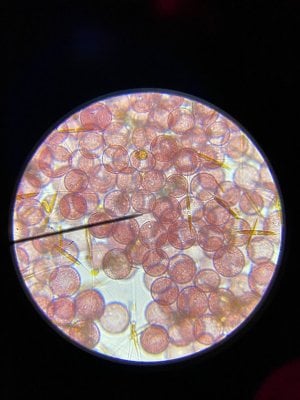
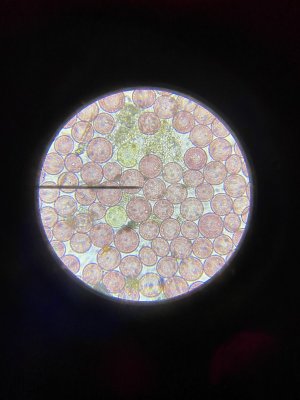
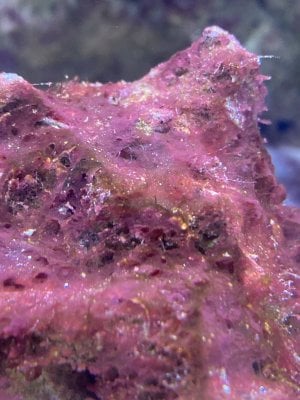
I agree on the ID based on color and film/slime appearance. It is the darn organism as @taricha points out that are not only what we did not expect to see but also do not give us clues as to what they are. The thick sheath that surrounds the organism might be a clue. Lots of things make snotty or slimey films and won’t help much.
Obviously these are cyanobacteria of spherical shape (coccal), maybe Synechococcus or similar. I thought I knew a red coccal cyanobacterium but I don't recall the name.
Sometimes I find single cells of red coccal cyanobacteria when I examine sediment samples under the microscope but never forming mats yet.
I'm not so sure you can just say obviously red cocci = cyanobacteria. They may be but from that pic there's no way I would make that proclamation.
So with that in mind I could also guess this could be a single cell rhodophyta, like Poryphridium sp.
What magnification is this? And with that knowledge what is the estimated diameter?
Anyways id culture them out. Don't know if you have the tools available to go that in depth though.
- Joined
- Sep 21, 2018
- Messages
- 6,720
- Reaction score
- 7,197
How about Haematococcus?I'm not so sure you can just say obviously red cocci = cyanobacteria. They may be but from that pic there's no way I would make that proclamation.
So with that in mind I could also guess this could be a single cell rhodophyta, like Poryphridium sp.
What magnification is this? And with that knowledge what is the estimated diameter?
Anyways id culture them out. Don't know if you have the tools available to go that in depth though.
Maybe? The main described species is freshwater, but apparently can grow in seawater in certain situations.Haematococcus
Also check Flintiella sanguinaria. Produces lots of exopolysaccharide. Brackish for that species but maybe another Flintiella sp. is marine.
You can try various staining techniques, also look for mitotic cells to see if you can see spindles, and/or test antibiotic sensitivities.
- Joined
- Aug 24, 2016
- Messages
- 1,506
- Reaction score
- 2,299
Haematococcus are feshwater species. The red cysts are not slimy. Haematococcus is not wine red, more a clear red (German name "Blutregenalge", blood rain alga) or brick red.How about Haematococcus?
The wine red color points to cyanobacteria or red algae. Both have the same pigments, phycobilins.
- Joined
- Sep 21, 2018
- Messages
- 6,720
- Reaction score
- 7,197
Great observations! Thank you.Haematococcus are feshwater species. The red cysts are not slimy. Haematococcus is not wine red, more a clear red (German name "Blutregenalge", blood rain alga) or brick red.
The wine red color points to cyanobacteria or red algae. Both have the same pigments, phycobilins.
- Joined
- May 22, 2016
- Messages
- 6,575
- Reaction score
- 10,161
@Dan_P how much fun do you want to have?
For maximum fun, suck up a tiny amount of the stuff (pure is better) and do a cycle or two of freeze/thaw in plain water.
It'll turn the plain water pink - phycoerythrin, the pigment from cyano and red algae is water soluble.
(In the unlikely event it doesn't turn the water pink, then we're off base. That means it's not phycoerythrin and thus not a rhodophyte or cyano. Puts other wild cards from different lineage like haematococcus - red pigment is non-water soluble astaxanthin - back in play.)
Then take your pink water, filter or centrifuge, and run it in the spectrophotometer.
r-phycoerythrin from rhodophytes is spectrally different from c-phycoerythrin from cyanobacteria.
R-phycoerythrin - from red algae has a strong shoulder at a smidge under 500nm

C-phycoerythrin (from cyanobacteria) has none or much less of a shoulder there in the 500nm ballpark.

I found that the difference shows up in spectra measurable from tank organisms
Red algae (gracilaria probably)

(coralline algae has the same features - it's a red algae too).
and cyano from a purple photosynthetic sponge

(red oscillatoria had almost the same features as here.)
In both cases, black lines are the measured spectra, and the other lines are me fitting pigments to match the observation.
For maximum fun, suck up a tiny amount of the stuff (pure is better) and do a cycle or two of freeze/thaw in plain water.
It'll turn the plain water pink - phycoerythrin, the pigment from cyano and red algae is water soluble.
(In the unlikely event it doesn't turn the water pink, then we're off base. That means it's not phycoerythrin and thus not a rhodophyte or cyano. Puts other wild cards from different lineage like haematococcus - red pigment is non-water soluble astaxanthin - back in play.)
Then take your pink water, filter or centrifuge, and run it in the spectrophotometer.
r-phycoerythrin from rhodophytes is spectrally different from c-phycoerythrin from cyanobacteria.
R-phycoerythrin - from red algae has a strong shoulder at a smidge under 500nm
C-phycoerythrin (from cyanobacteria) has none or much less of a shoulder there in the 500nm ballpark.
I found that the difference shows up in spectra measurable from tank organisms
Red algae (gracilaria probably)
(coralline algae has the same features - it's a red algae too).
and cyano from a purple photosynthetic sponge
(red oscillatoria had almost the same features as here.)
In both cases, black lines are the measured spectra, and the other lines are me fitting pigments to match the observation.
- Joined
- Sep 21, 2018
- Messages
- 6,720
- Reaction score
- 7,197
You know that I hate fun@Dan_P how much fun do you want to have?
For maximum fun, suck up a tiny amount of the stuff (pure is better) and do a cycle or two of freeze/thaw in plain water.
It'll turn the plain water pink - phycoerythrin, the pigment from cyano and red algae is water soluble.
(In the unlikely event it doesn't turn the water pink, then we're off base. That means it's not phycoerythrin and thus not a rhodophyte or cyano. Puts other wild cards from different lineage like haematococcus - red pigment is non-water soluble astaxanthin - back in play.)
Then take your pink water, filter or centrifuge, and run it in the spectrophotometer.
r-phycoerythrin from rhodophytes is spectrally different from c-phycoerythrin from cyanobacteria.
R-phycoerythrin - from red algae has a strong shoulder at a smidge under 500nm

C-phycoerythrin (from cyanobacteria) has none or much less of a shoulder there in the 500nm ballpark.

I found that the difference shows up in spectra measurable from tank organisms
Red algae (gracilaria probably)

(coralline algae has the same features - it's a red algae too).
and cyano from a purple photosynthetic sponge

(red oscillatoria had almost the same features as here.)
In both cases, black lines are the measured spectra, and the other lines are me fitting pigments to match the observation.
Your survey is very interesting. Obtaining a visible spectrum did cross my mind, but I am trying to avoid going down too many rabbit holes these days...but if this organisms takes off, I probably will give in to extracting pigments.
On Saturday I started the liquid bacteria / hydrogen peroxide treatment that @vetteguy53081 recommended. Tues afternoon I'd not seen any results and thought it wasn't working so I didn't dose the peroxide that night. By the next afternoon I was surprised by a change! I started seeing small round spots where the sand was beginning to clear. It seems to be clearing from the left side of the tank to the right. These pics were just taken. The tank started out with the sand completely covered like it is here in the front corner, it was always thicker to the front of the tank. The second pic is the left side of the tank. I was planning to do a water change tomorrow to try to remove as much as I can and see if the treatment keeps it at bay.


vetteguy53081
Well known Member and monster tank lover
View Badges
Partner Member 2024
Excellence Award
Reef Tank 365
RGB
Article Contributor
Tampa Bay Reef Keepers
West Palm Beach Reefer
Hospitality Award
Ocala Reef Club Member
305 Reef Club
Wisco Reefers
Midwest Reefer
Fish Medic
MAC of SW Florida
Rock Pool Reef Keepers
R2R Secret Santa 2023
My Tank Thread
My Aquarium Showcase
Thi
This is cyano and make sure to follow what was mentioned precisely. Glad you’re seeing improvementOn Saturday I started the liquid bacteria / hydrogen peroxide treatment that @vetteguy53081 recommended. Tues afternoon I'd not seen any results and thought it wasn't working so I didn't dose the peroxide that night. By the next afternoon I was surprised by a change! I started seeing small round spots where the sand was beginning to clear. It seems to be clearing from the left side of the tank to the right. These pics were just taken. The tank started out with the sand completely covered like it is here in the front corner, it was always thicker to the front of the tank. The second pic is the left side of the tank. I was planning to do a water change tomorrow to try to remove as much as I can and see if the treatment keeps it at bay.


Will it be ok to do the water change? Or should I hold off for a bit?Thi
This is cyano and make sure to follow what was mentioned precisely. Glad you’re seeing improvement
Similar threads
- Question
- Replies
- 3
- Views
- 194
- Replies
- 2
- Views
- 217
- Replies
- 1
- Views
- 105





